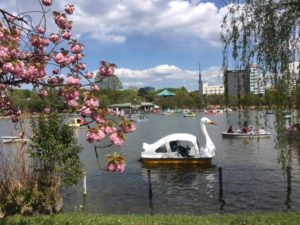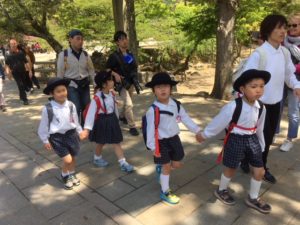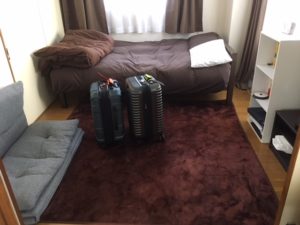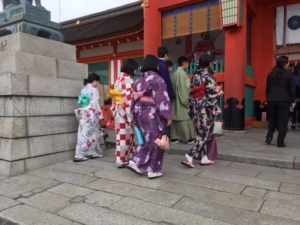
Sunday afternoon in Ueno Park, Tokyo.
Second in a Series
My previous travel experiences in Japan had been very brief before my wife, Catharine, and I flew off to Tokyo in early April, so I wasn’t sure what to expect.
How much of a language barrier would we find? Is Japan as expensive as it’s reputed to be? Would we face greater-than-average logistical problems there?
Those taking an organized tour to Japan can avoid most of these potential problems, of course, but — just as some people enjoy figuring out how cars or watches work — I like figuring out how to get from Point A to Point B while traveling as efficiently and economically as possible.
I also like to follow my own schedule, choose my own lodgings and restaurants, and not have to follow a guide around. (This isn’t to say that I haven’t enjoyed some wonderful tours in my travels or that I would try to dissuade anyone from taking one — the advantages of tours are many. But if you like traveling independently like me, read on….and if you’re undecided or just feel like it, read on, anyway.)
Traveling on your own means doing sufficient trip prep before leaving, because the more you do before landing at your destination, the more time you’ll have for the really fun stuff when you arrive.
Getting Started
When we first decided to go to Japan — based on scoring a couple of half-price tickets on Singapore Airlines via Scott’s Cheap Flights (highly recommended!) — I bought a couple of guidebooks: the latest editions of Lonely Planet Japan and Japan by Rail (both available from Amazon and many bookstores), since we knew we wanted to use trains for our long-distance travel.

Spring in Japan means blossoms everywhere.
Several days each in Tokyo and Kyoto were a given, and we decided on our other two main destinations — Nara and Nikko — based on reading the guidebooks as well as the recommendations of a friend who had lived in Japan. The fact that Nara was close to Kyoto and Nikko was close to Tokyo were big factors, since we had just two weeks to complete the entire trip.
A quick check of Catharine’s passport indicated she would be due for a new one soon, so we took care of renewing it right away. No visas are necessary for U.S. citizens traveling to Japan for pleasure for less than 90 days, so that was it for documentation.
Japan Rail Passes
Our first purchases were two Japan Rail Passes, which allow you to board almost any “JR” train in the country for unlimited travel at a reasonable price. We opted for one-week passes since we planned to spend much of the first week in Tokyo anyway.
These passes would get us from Tokyo to Kyoto and back, as well as to Nara and Nikko. Of course, once we found how comfortable, clean, fast, and reliable Japanese trains are, we were also tempted to just ride them for a week, exploring the countryside — but we stuck to our schedule and wouldn’t have wanted to miss any of our planned destinations.
The passes cost $263 for one week, $419 for two weeks, and $537 for three weeks. First class passes cost a bit more, children a bit less — and while first class looked appealing, we were plenty comfortable in “ordinary” class. Along with the half-price plane tickets, our trip to Japan was already looking like something of a bargain.
You don’t actually receive the passes while still in the U.S. — rather, you receive vouchers for them that you exchange at a JR office in Japan, which you can find at major tourist hubs. (Be sure to order them before leaving the U.S., however.) You show them your passport, tell them the date you want the pass to start, and make seat reservations for trains you know you want to take.

Uniformed schoolchildren in Nara, Japan.
I recommend making seat reservations — especially for any long-haul trains — because, while there are always some cars left unreserved, they tend to fill up quickly. And…they’re free.
We purchased our passes through the site Japan Experience, but there are plenty of other options.
We also ponied up an extra $23 for “JPR Assistance,” which promised phone help for any problems encountered while using or scheduling trains, but we never used it, or came close to needing it. The JR representatives and conductors were always knowledgeable and helpful when we found ourselves needing a reservation or finding the right train car.
Subway Passes
Knowing we would get around Tokyo mostly by subway (“metro”), we bought two pre-paid “Pasmo” cards, which can be used for public transportation (including buses and trains) in major cities around the country, as well as for certain other expenditures. (Similar “Suica” cards are also sold.)
As purchased through Japan Experience, they each come pre-loaded with 1,500 yen (about US $14) worth of rides, with an amount deducted each time you enter the subway or local train station (JR trains circle the city as well.)
Once you’ve used that much up, there are machines within the stations to add more yen (and gate attendants are glad to help you navigate through the instructions.) Despite taking a number of rides, we needed to top them off only once, and returned with some credit still available on each — but since they’re good for ten years, it’s a great excuse to return to Japan!
Booking Lodgings
We relied on a combination of airbnbs, hotels, and traditional guest houses — all pre-booked — as we made our way around the country.
Pre-booking was essential as we were arriving around cherry blossom time, one of Japan’s busiest seasons. (I strongly recommend it at any time of year, though, if you’ve figured out your schedule.)

Our first airbnb in Tokyo — tiny but comfortable.
We enjoyed all the different types of lodging: The airbnbs enabled us to get to know neighborhoods in Tokyo and Kyoto and live for a few days as the Japanese do in their tiny apartments; the traditional guest houses offered a look at how budget-minded Japanese themselves travel; and the hotels provided a nice respite from the tiny bathrooms (sometimes shared) and bedding rolled out on floor mats of the airbnbs and guest houses.
Had I to do it over, however, I would have eliminated the places with the shared bathrooms and gone easier on the places with the bedding on the floor — we discovered that as we’ve gotten older, it gets more difficult to get out of bed (or, should I say, get out of bedding) all the way up from a floor mat.
While I wouldn’t have wanted to miss the experience entirely, one night of that would have been plenty.
Packing for Japan
Knowing that space in Japan is at a premium and that we didn’t want to have to lug large suitcases up and down steps or hoist them into overhead racks on trains, we were determined to pack only enough to fit into two carry-on sized four-wheel bags, along with my lightweight backpack and Catharine’s roomy purse.
This was the smartest decision we made the entire trip.
While most subway and train stations have escalators and elevators, we were still sometimes confronted with long flights of steps at those locations as well as at our lodgings.
The airbnb and guest houses were generally tiny — no extra room there.
And our little carry-ons fit comfortably in front of our train seats — so we didn’t even have to hoist them up onto the overhead racks.

Kyoto women in traditional garb.
As it turns out, we didn’t even need everything we brought — I could have gotten by with just one pair of shoes and with two fewer shirts.
But, with the help of miracle lightweight roll-up fabrics and lots of planning, Catharine the miracle packer managed to squeeze in raincoats, down jackets, vests, three pairs of pants, several shirts, underwear, toiletries, and various other items with even a little room to spare.
The Narita Express
If you’re flying into Japan via Narita, Tokyo’s main international airport, it’s convenient to buy a round trip train ticket from Narita into Tokyo unless you’re planning to use your Japan Rail Pass right away.
If the latter’s the case, look for the JR office at the airport, exchange your voucher for your pass, and be on your way.
Otherwise, look for the JR desk selling “Narita Express” round trip tickets, which at the present time cost 4,000 yen each (a bit less than $38 by recent exchange rates).
The trip takes an hour and 20 minutes to reach Tokyo and the trains make several stops in the city at the most frequented train/subway stations.
Once you’re on board, you can sit back and relax a while as the train speeds through the Japanese countryside on its way into the capital.
But don’t get too relaxed — you’ll soon be facing the pulsating, occasionally overwhelming reality of modern-day Tokyo. More on that in my next post.
All photos by Catharine Norton
For my first post on Japan, see Eight Great Reasons to Visit Japan












2 Responses to How to Prep for a Trip to Japan